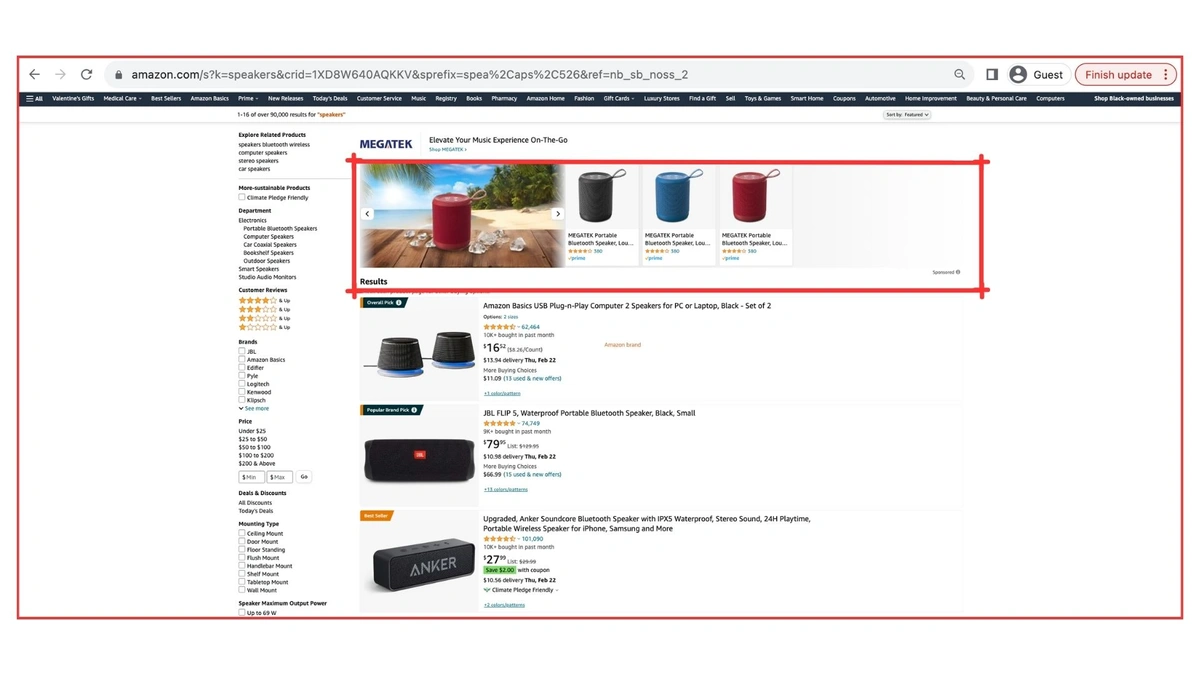Are you a seller on Amazon looking to increase your sales and brand awareness? Amazon advertising is a great way to do just that.
But with so many different ad types and placements, it can be overwhelming to know where to start.
In this article, we'll focus on Amazon ad placements and strategies for effective ad placement.
Read on to learn how to leverage placements for maximum impact, from basic tactics to advanced strategies.
Developing Effective Amazon Ad Placements
When it comes to Amazon advertising, developing effective ad placements is crucial to the success of your marketing strategy. Here are the key components of crafting a successful Amazon ad placement strategy.
Understanding Amazon's Ad Ecosystem
To develop effective ad placements, it's important to understand Amazon's ad ecosystem.
Amazon offers several advertising options, including Sponsored Products, Sponsored Brands, Sponsored Display, and Amazon DSP.
Each option offers unique benefits and targeting capabilities, and understanding how they work together can help you create a comprehensive advertising strategy.
Creating Your Amazon Ads Strategy
Creating an effective Amazon ads strategy requires careful consideration of your budget, competition, and advertising goals.
Start by setting a realistic budget for your PPC campaign and determining your target audience. From there, you can create ad campaigns that target specific products, categories, or keywords.
Read our guide on the 10 proven Amazon PPC strategies to get Amazon results.
Optimizing for Placement and Performance
Optimizing for placement and performance is key to ensuring your ads are seen by the right audience and driving conversions. Here’s a guide on how to optimize your ad placement.
-
Choose Ad Placement: Start with selecting where your ads will appear. Amazon allows placements on product detail pages, within their store, and on customer review pages.
For example, if you're selling a cookbook, place your ad on related kitchenware product pages.
-
Adjust Bids by Placement: Modify your bids for different placements to improve ad performance. If top-of-search results in more conversions, you might bid higher for that spot.
Bid more on a high-visibility placement during a holiday season when competition is fierce.
-
Utilize Product Targeting: Target customers interested in similar products. For example, if you’re selling yoga mats, target ads to show on pages for yoga accessories like blocks and straps.
-
Monitor ACoS: Keep an eye on your ACoS, the ratio of ad spend to sales, and adjust your bids to improve ROI. If ACoS is high, you might lower your bid or refine targeting. So if your ACOS for a specific campaign is over 30%, review your keywords and bids to find where you can cut costs.
-
Ongoing Optimization: Continuously refine your strategy by analyzing ad performance and making necessary adjustments. If a particular ad isn't performing well, either change the creative, tweak the targeting, or adjust the bid.
Maximizing Visibility and Conversion
Here are some effective strategies for maximizing visibility and conversion through ad placements.
Leveraging Keywords and Product Listings
One of the most important factors in optimizing your ad placements is to leverage the power of keywords and product listings.
Conduct thorough keyword research and optimize your product listings with relevant keywords to improve your organic rankings. This will not only help your products appear higher in organic search results but also improve the performance of your sponsored ads.
When setting up your ad campaigns, use Amazon Advertising to target specific keywords and placements.
Sponsored Brand Ads, Headline Search Ads, and Video Ads are all great options for increasing visibility and driving conversions.
Additionally, Amazon's Brand Registry program can help you protect your brand and improve your search engine optimization (SEO) by providing access to unique features such as Enhanced Brand Content and A+ Content.
Enhancing Ad Reach with Amazon's Unique Features
Amazon offers a variety of unique features that can help you enhance the reach of your ad campaigns.
For example, Amazon Live and Fire TV can help you reach a wider audience and increase engagement with your brand.
Additionally, Amazon Attribution can help you track the performance of your ads across multiple channels, allowing you to make data-driven decisions about your ad placements.
Another effective strategy for enhancing ad reach is to bid aggressively on alternative keywords. This can help you reach customers who are searching for products similar to yours but may not be using the exact keywords you are targeting.
Use Amazon's algorithm to analyze data and adjust your bids accordingly to improve your return on ad spend (RoAS) and conversion rate.
Analyzing Data for Informed Adjustments
To make informed decisions about your ad placements, it's important to analyze data and adjust your strategies accordingly.
Use Amazon's reporting tools to track the performance of your ad campaigns and identify areas for improvement.
Also, pay attention to metrics such as click-through rate (CTR), conversion rate, and cost per click (CPC) to make informed decisions about your ad placements.
Conclusion: Amazon Ad Placement Strategies
Success on Amazon PPC depends on placing ads where they'll get noticed by the right people. Using the right keywords ensures your ads show up for interested buyers, and increasing bids for the best spots can make your products stand out.
Keep an eye on how your ads perform, making changes as needed. Try different spots and bidding methods to see what's most effective for your items. With some smart planning and active management, your ads will work harder for you, leading to more sales.
To amplify these efforts, our Amazon PPC plans are your ticket to mastering ad placements. Elevate your advertising with our PPC plans and watch your business soar.
Frequently Asked Questions on Strategic Ad Placements on Amazon
What is ad placement in Amazon?
Ad placement on Amazon refers to the location where your advertisements are shown on the platform, such as on search results pages, product detail pages, or within Amazon's advertising network.
How do I get my ad on top of Amazon?
To get your ad on top of Amazon, you need to use Amazon Sponsored Products and bid competitively on relevant keywords, ensuring your product listings are optimized for conversion and relevance to the searched terms.
How does Amazon use product placement?
Amazon uses product placement by strategically positioning products in search results, on product detail pages, and through recommendations to increase visibility based on consumer behavior, search relevancy, and advertising campaigns.
What's the difference between automatic and manual targeting for Amazon Ads, and how does this affect placement?
Automatic targeting allows Amazon's algorithm to select keywords and placements based on your product information, while manual targeting enables you to choose specific keywords and customer segments. Your choice affects placement since it determines how closely your ads align with specific searches or customer interests.
How often should I adjust bids for different placements?
It's recommended to review and adjust your bids regularly, at least once every week or two weeks, based on the performance data. Keep an eye on key metrics like ACOS and conversion rate to determine if your placement bids need optimization.
How can I use Amazon DSP to improve ad placements?
Amazon DSP (Demand-Side Platform) allows you to programmatically buy ad placements across Amazon sites and apps as well as third-party publishers' websites. With DSP, you can use detailed targeting options to place your ads in front of specific audiences, improving the likelihood of reaching potential customers.
Is it beneficial to use Sponsored Brands for ad placements if I only have a few products?
Sponsored Brands can still be beneficial for businesses with a small product range by increasing brand awareness and driving traffic to your custom Amazon Store or a curated collection page. This can be particularly effective if you're looking to establish your brand presence on Amazon.



 Scale Insights Team
Scale Insights Team


